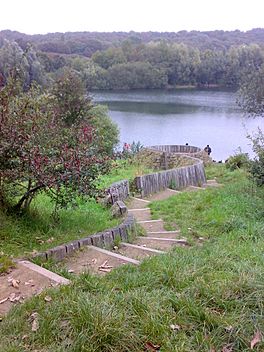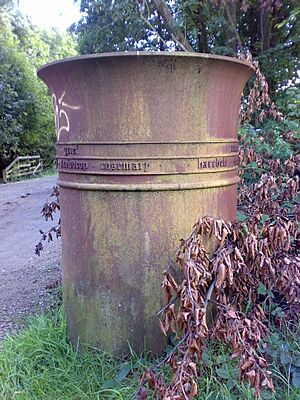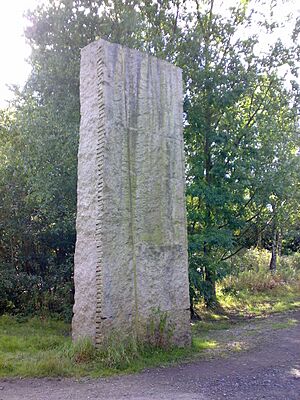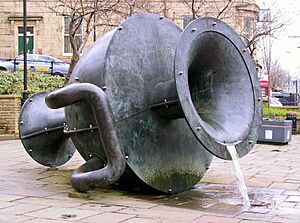Irwell Sculpture Trail facts for kids
Quick facts for kids Irwell Sculpture Trail |
|
|---|---|

The Lookout is a sculpture site on the trail
|
|
| Length | 30 mi (48 km) |
| Location | Northern England |
| Trailheads | Salford Quays |
| Use | Walking |
| Season | All year |
The Irwell Sculpture Trail is a special outdoor art gallery in England. It's the biggest collection of public art in the country. Many artists from around the world have created artworks for this trail.
The trail has 28 art pieces. It follows a walking path that is about 30 miles (48 km) long. This path starts at Salford Quays. It then goes through Bury, into Rossendale, and up to the Pennines near Bacup.
Contents
- Exploring the Irwell Sculpture Trail
- Art from Chapel Street to Peel Park
- Art from Peel Park to Agecroft
- Art from Clifton to Prestwich
- Art at Clifton Country Park
- More Art from Clifton to Prestwich
- Art in Radcliffe
- Ulrich Rückriem's Stone Art
- Nailing Home: A Sculpture for a Community
- Art in Bury
- Art in Ramsbottom
- Art in Irwell Vale
- Art in Rawtenstall
- Art in Waterfoot
- Art in Bacup
- Art in Deerplay
Exploring the Irwell Sculpture Trail
Art from Chapel Street to Peel Park
The Fabric of Nature: A Bud and Leaf Sculpture
This artwork looks like a bud and a leaf when you see it from above. It's shaped like a double spiral mound. You can walk up it to a curved brick seating area.
Leaf shapes and patterns are set into the brick path. These help people explore the park. The sculpture mixes old park designs with natural shapes. For example, it shows the spiral patterns found in a daisy. The design also includes seating and bright colors, as people asked for these features.
Art from Peel Park to Agecroft
Arena: A Tall White Sculpture
Arena was finished in 2002. It is a public sculpture made by artist Rita McBride from New York. It is made of white concrete and stands over 15 feet (4.6 meters) tall. You can see it from the Littleton Road playing fields and the River Irwell. This was the first big artwork for the Irwell Sculpture Trail in Salford.
Art from Clifton to Prestwich
Arresting Time: Industrial Art
Jill Randall created Arresting Time. She spent time at a factory called Magnesium Elektron Limited. This factory makes metal alloys. The sculpture hangs from the riverbank. It is made of alloy and looks like the machines in the factory. It shows how industry influenced the artist.
Art at Clifton Country Park
The Lookout: A Quiet Spot by the Lake
The Lookout was built in 2003 by Tim Norris and Craig Ormerod. It is built into the bank of Clifton Marina lake. It lets people get closer to the water. It's a peaceful place to relax and think.
More Art from Clifton to Prestwich
The Dig: A Tribute to Old Boats
The Dig sculpture was inspired by the area's industrial past. It reminds us of the "starvation boats." These boats were used to carry materials from the Wet Earth Colliery coal mine to Salford Quays. They were called "starvationers" because they were very narrow. This narrow shape was needed to fit through the canals.
You can still see parts of these old boats in the dried-up Fletcher's Canal. The artist also thought about old buried ships and ancient Iron Age forts. The Dig sculpture can also be used as a place to sit, eat, or watch performances.
Art in Radcliffe
Trinity: Remembering Railway Workers
The artwork called Trinity remembers the time when the railway line was built. Many workers, called 'navvies', died while digging the Outwood cutting. The sculpture also looks at the history of the area before the railway.
The flowers carved on the sculpture have special meanings. They remember the workers who were lost.
The meaning of flowers was well known during the Victorian era, when the railway was built. The sculpture also looks like a tree. This helps it blend in with the surrounding woodlands. The artist wanted to show how the area changed from nature to industry and back to nature.
Our Seats Are Almost Touching: A Circular Bench
Another sculpture here is Our Seats Are Almost Touching. It's a bench made of dark grey concrete. The full bench would form a circle. But it's split into eight pieces of different sizes. These pieces are placed as single seats or in groups. Each part of the bench offers a nice view or a quiet spot to think. This artwork is part of a series of benches the artist started in 1994.
Ulrich Rückriem's Stone Art
At the old Outwood Colliery coal mine, Ulrich Rückriem created a large stone artwork. It has ten big stone pieces placed in different spots. Two tall columns mark the entrances. Seven tall slabs are on a flat area. The biggest slab, 25 feet (7.6 meters) tall, marks the old railway track. These stones were split into parts and then put back together.
Nailing Home: A Sculpture for a Community
Nailing Home: A Giant Nail Sculpture
The Nailing Home sculpture was made for a new housing area. It was inspired by children's rights and the name of the housing development. The area is called Shire Gardens because the mill owner used to keep Shire horses there. This sculpture marks the entrance to the new homes. It is the first big public artwork by Jack Wright, a sculptor from Radcliffe.
The sculpture looks like giant frost nails. These nails were used to help Shire horses walk on ice. The stem of the nail looks like growth. The head looks like a house roof. This connects to the Irwell Valley Housing Association, which built social housing here.
Each nail has a line from the poem 'Children Learn What They Live'. This poem reminds us how our actions affect children's lives. This project was a team effort between the Irwell Sculpture Trail and Irwell Valley Housing Association.
Bulrushes: A Hidden Canal Barge
In the Bulrushes, there is another sculpture. It is made of steel. The artwork is inspired by the nearby Manchester Bolton & Bury Canal. It has bulrush shapes and a canal barge hidden at the bottom. At night, lights make the sculpture glow.
Art in Bury
As If I Were A River: Understanding the Landscape
As If I Were A River is about the river itself. This artwork helps people understand their local area. It also encourages them to explore their surroundings.
- Water Wheel: This sculpture is made of painted steel and stone. It marks the entrance to Burrs Country Park. This park was once a large cotton mill. The artwork looks like an old waterwheel that powered the mill. The wheel shows how things constantly change. It shows how the river changed into an industrial site and then back into countryside.
- Stone Cycle: The artist worked at the site to understand its history. The sculpture shows the passing of time and changes in the area. It is made of stones that were once part of a bridge. The artist found old marks made by the original builders. New carved symbols were added to these marks.
- Picnic Area: This sculpture is a giant rat trap made of stainless steel. The words "picnic area" are written on it. It is placed where a canal and a small river meet. These waterways once fed the cotton mill. The sculpture is a funny comment on the site's hidden past. It also makes visitors wonder if it's a real picnic spot or a "tourist trap."
Art in Ramsbottom
Seek And You Will Find: Hidden Wooden Sculptures
This artwork is a series of carved wooden sculptures. They are inspired by the plants found around the park. The artworks are "secretive" and hidden among the plants. Their shape comes from the Ramson herb. The town's name, Ramsbottom, comes from this herb.
- The River: This is a winding path about 90 yards (82 meters) long. It ends at a platform where you can watch trains go by. The sculpture includes poems and stories created by local people. These celebrate the river and a local beauty spot called Jacob's Ladder.
- Tilted Vase: (1998) by Edward Allington. This sculpture is inspired by the Industrial Revolution in the valley. It has a classic shape, like old buildings. It is built in sections and bolted together, making it look like a machine.
Art in Irwell Vale
- In The Picture: (1997) by Richard Caink. This artwork looks like a picture frame. Old landscape paintings often used frames to show who owned the land. The carvings on the frame show things related to the valley's industry. They also show the loom-wreckers rebellion of 1826. Visitors can step into the frame and become part of the picture.
- Remnant Kings: Large pieces of local ash wood are held in a steel cog. This design suggests movement. It looks like the wood is being thrown forward, releasing stones like seeds. The artist says, "Remnant Kings stands proud on the hillside watching over its kingdom waiting for its chance to scatter."
Art in Rawtenstall
- Whispering Wall: This sculpture is inspired by the water systems in the Rossendale Valley. It uses local stone, old pipes, and the sound of running water. An underground tank acts as an echo chamber. Pipes spread out from it to holes in a stone wall. A blue light shines through the holes. If you listen closely, you can hear whispered voices and sounds from nature.
- Gateway: This artwork is made of steel, mosaic, and cobblestone. Railway lines form the archway of the gates. Steel panels are cut with images of steam train wheels. This shows the area's history and its connection to railways.
- Willow Tree sculpture: This is a large outdoor maze on a hillside. It has a series of tunnels. On either side are large turf kilns. One is beehive-shaped for smelting metal. The other is a ziggurat shape for burning charcoal. There are also two chimneys, which Rossendale was once famous for. This sculpture has become an outdoor classroom for learning about the environment.
- The Bocholt Tree: This sculpture celebrates Rossendale's links with its German twin-town, Bocholt. The sculpture is a symbol of friendship between the people of Rossendale and Bocholt. It reminds people that they have friends in other parts of Europe. Bocholt's symbol is a tree. The sculpture is made of painted metal.
Art in Waterfoot
- Logarythms: This is a zig-zag resting place for walkers. The sculpture has a simple math design. It gets longer and taller as it zigzags down the slope. It is made of logs.
Art in Bacup
- Weave: This sculpture was inspired by the local textile industry. It looks at fabric under a microscope. It shows how threads move in and out to create a woven pattern. Weave also refers to the local landscape. The peaks and troughs of the hills are like the woven pattern.
- Coming Full Circle: This sculpture is a maze made of dry-stone walls. It has five spiraling walls and five paths. There is a quiet seat in the middle. The pattern of the wall looks like the whirlpool movement of water. This water once turned wheels that powered a local felt factory. The five exits lead to paths through hawthorn, cherry, and apple trees. When these trees bloom, their white flowers will look like turbulent water. This sculpture has an oak tree in its center. It shows the idea that time moves in a circle, and the land will return to woodland.
Art in Deerplay
- Sentinel: This sculpture uses two traditional skills from the valley: dry-stone walling and felting. The artist learned stonewalling from a local expert. In return, the artist taught felt-making to young people. A sentinel is a soldier who guards a special place.





